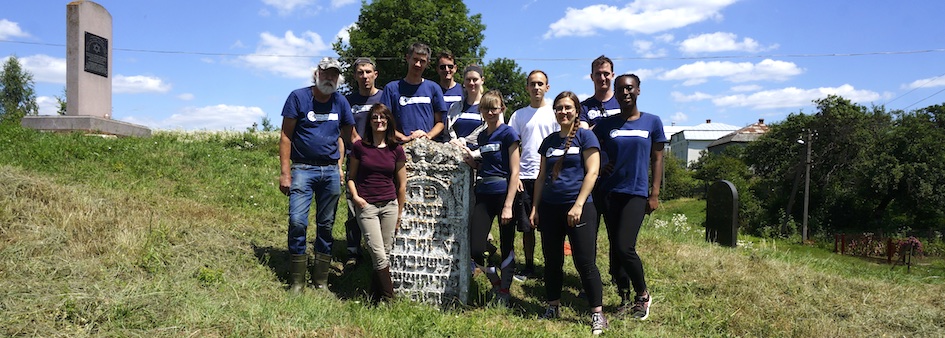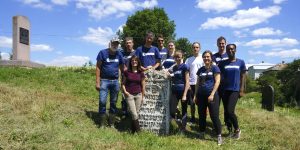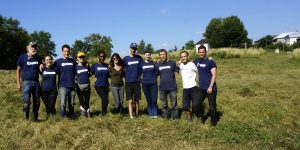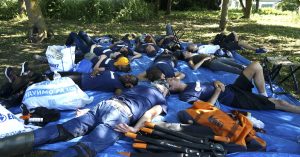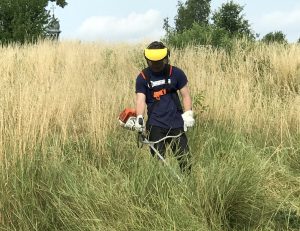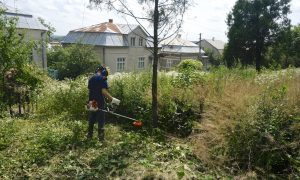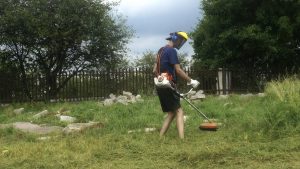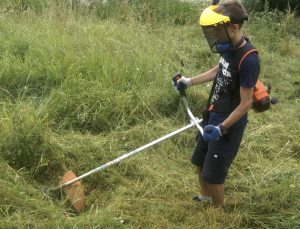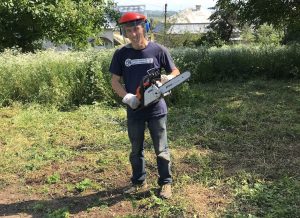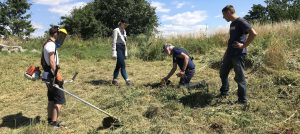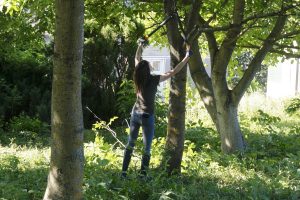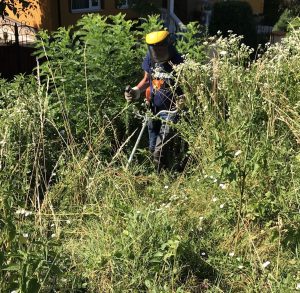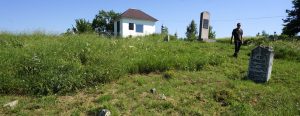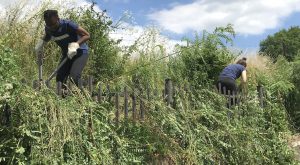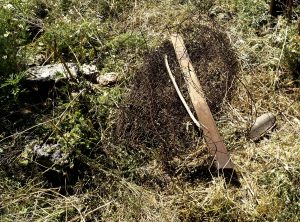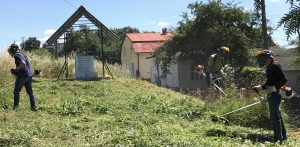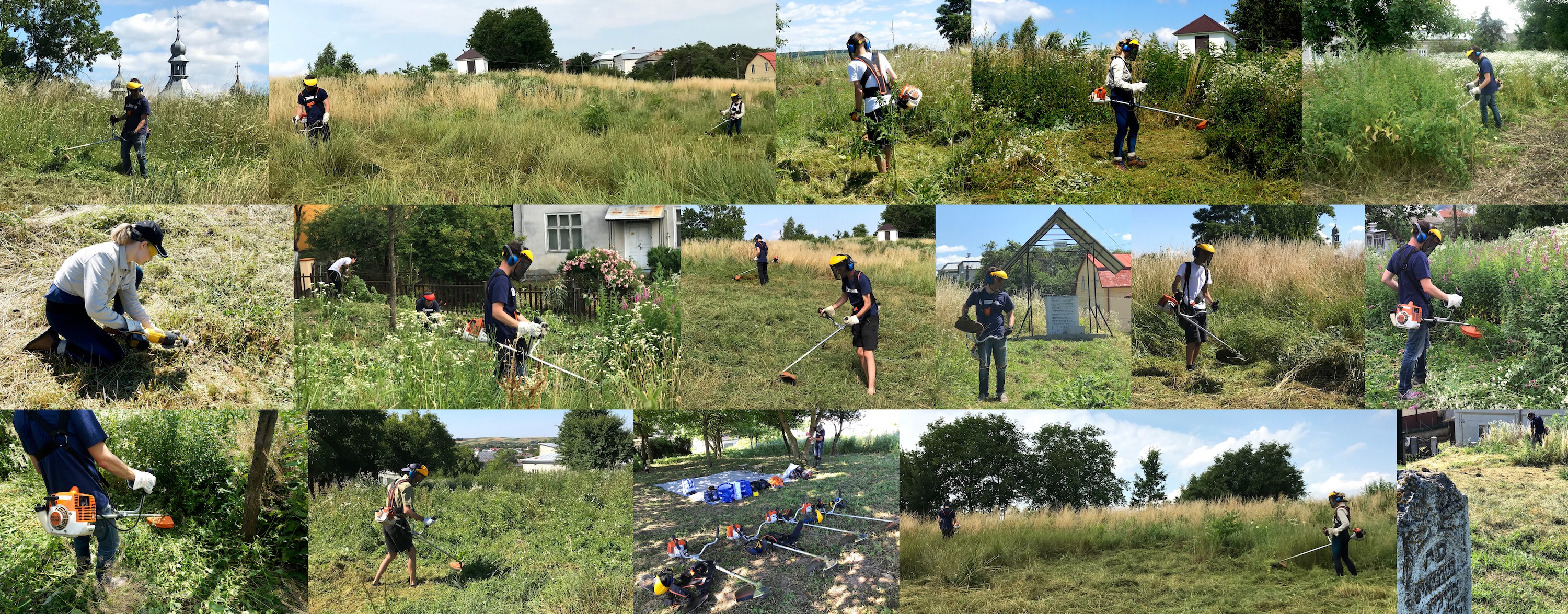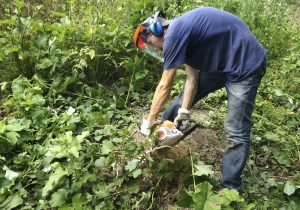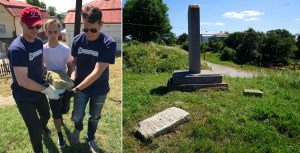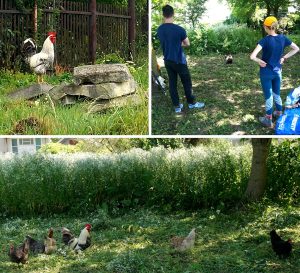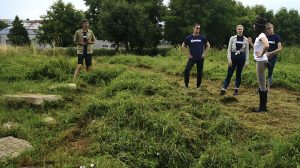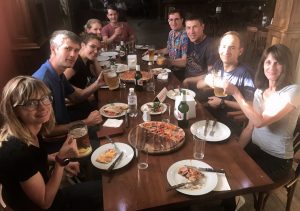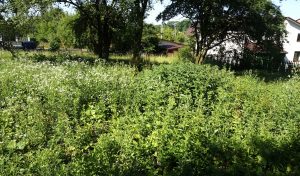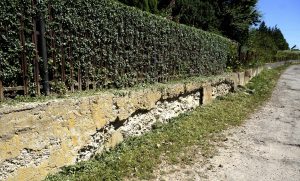This week, Marla and I again had the great pleasure of working with friends from all over Ukraine, both Americans and Ukrainians, to further advance the efforts of Rohatyn Jewish Heritage in clearing and conditioning the vegetation and grounds of one of Rohatyn’s key Jewish heritage sites, the old Jewish cemetery. As they say, together we made hay – and a lot more – while the sun shone.
Indeed, the sun wasn’t merely shining: the heat and humidity were intense at the start of the event, so we all had to be careful to monitor our own temperatures and take rest breaks in the shade with lots of water. Despite the heat, we made great progress against several of our goals, both in vegetation clearing and also in introducing Rohatyn and its Jewish history and heritage to many more interested visitors.
![]() Ця стаття також доступна українською.
Ця стаття також доступна українською.
Our Goals This Week
A five-day major volunteer event at the old Jewish cemetery in August last year, plus two smaller one-day events last year, two one-day tool trials this year, one complex day during a large volunteer event this past May, and a small three-day event in June, all have helped to remove large wild-growing brush and small trees, plus hard debris and garbage, from the interior of the cemetery. This past effort was the first important step toward conditioning the cemetery landscape, needed to simplify and ease annual maintenance; it also made it possible to see from end to end of the cemetery for the first time in years.
Building on that past work, our goals for this week’s effort were to:
- cut back wild growth on both sides of the cemetery fence at the southeast corner and along the long south edge, to dress the most-visible face of the site;
- mow down thick wild grass and light shrubs across a large portion of the cemetery interior, to suppress fast-growing woody plants which had taken over the site in past years;
- continue to cut and grind the stumps of large shrubs and small trees, down to the ground surface, to reduce trip hazards and simplify future maintenance;
- continue clearing hard debris and garbage, to make visiting and caring for the site safer and easier.
Although the goals for this event appear similar to past projects, as we progress in our care of the site, the mix of tasks is shifting. The more success we have in removing hard materials (brush and tree stumps, plus debris) from the cemetery, the more efficient we become in mowing and pruning.
Our Amazing Volunteers
Several trial work days with just a few hands in fall last year and spring this year made plainly evident that even just one full pass of clearing and cleaning at all of the Jewish heritage sites in Rohatyn requires many people working many days, far more than RJH could ever achieve on our own. So it is with profound gratitude that we celebrate the many people who came from near and far to labor with us and to talk with us, demonstrating the volunteer spirit which inspires us and gives us the confidence to continue with our daily work.
Although we always welcome international volunteers, this event was interesting in that every volunteer was a current resident of Ukraine – though many were originally from America. Among other effects, this meant that the frequent humor was often centered on “local” Ukrainian concerns, from traditional (and untraditional!) food, to politics, to chickens, to the complex transport system, and much more. Conversations during rest breaks and over meals gave us all an opportunity to learn lessons from others’ experiences, and to sample the variety of culture and life in modern Ukraine.
Peace Corps in Ukraine
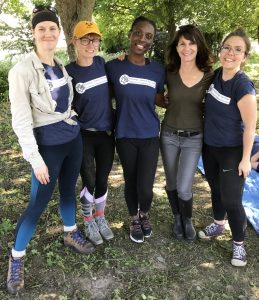
“Girl Power” was again formidable during this event: Carson, Alexis, Jahniece, Marla, and Kirsten.
Photo © 2019 RJH.
A recurring theme in our heritage preservation events is the tremendous impact made by individual volunteers working for the Peace Corps in Ukraine, coming together on their own time to make positive steps for the common good. As we have seen repeatedly over the past year, these people are remarkable; not only is volunteerism a core part of their lives, but they are also smart, adept at problem-solving, and constantly thinking and experimenting on ways to better address the challenges presented to them. We love that they originate from all over America, serving all over Ukraine, bringing a wide variety of perspectives and experience, but always with an open attitude to the new people they meet, including other volunteers and local townspeople from all walks of life.
For these three days we were fortunate to have three veterans of past Rohatyn events, already familiar with the heritage issues, tools, and methods: Kirstin Dyck (serving in Poltava), Carson Holstein (Brody), and Andrés Rodriguez (Rohatyn); Marla and I enjoyed learning more about their activities and progress in their host towns.
Welcomed as new friends and eager to make a positive mark were Aaron Karlin (Solone), Alexis Renee Lipson (Zhmerynka), and Jahniece Ororo McCollum (Chortkiv); it was great for us to hear about how Ukraine varies through its regions (just like America), and to share our own experiences staying in Chortkiv (twice in winter!).
All six PCVs took on a variety of tasks each day, learning the tools then cutting, mowing, grinding, hauling, and smiling the whole time, shrugging off the heat, insects, cuts, blisters, and pesky chickens throughout. It was particularly meaningful that our last day together was the fourth of July – US Independence Day – and these volunteers celebrated by working together to support an international heritage project with their hands and hearts. This is exactly the spirit they bring to their ongoing work as volunteers for the Peace Corps, for the benefit of Ukraine and America.
Rohatyn Jewish Heritage owes a special debt of gratitude to Rohatyn’s own Peace Corps Volunteer, Andrés Rodriguez, who, in addition to his hard work in the cemetery, also managed much of the coordination and communication among all of the volunteers to help get everyone housed and to and from the site each day, plus arranging dinners and more so the group could relax after the long work days. Andrés even cooked up a large pasta dinner for the PCVs at the end of the hardest day, to help everyone unwind. His local knowledge and his organizing skills were indispensable to Marla and me before and during this event, giving us much-needed time to focus on the tools and tasks. In addition to his teaching responsibilities for the Peace Corps, Andrés is also working to develop leadership opportunities and training for the youth of Rohatyn, and his skills in that area are evident in everything he does with and for us on our projects.
Ukrainian Colleagues and Friends
Marla and I particularly enjoy welcoming Ukrainian volunteers to our events, not only for their hard work and outstanding attitude but also because they help us to introduce the theme of local Jewish heritage as Ukrainian heritage to a wider group of citizens than we can reach on our own. Each of the friends and colleagues who join us in these events becomes an ambassador, in words and deeds, for positive, apolitical cultural diplomacy. And in addition, they are just great people we enjoy working with.
Denys Bulavin brought unflagging enthusiasm and strength from his home town of Lviv to join us for three full days of hard work. An engineer, Denys has an interest in the wide variety of history and cultural heritage of Ukraine, studying the many ethnic and religious groups who have made their home here, and he even gives tours of lesser-known sites in Lviv and the region which are off the radar of typical guides and tour companies. His study and his natural curiosity gave many of our break-time discussions interesting direction.
This week was the fourth time we have had the hard work and good cheer of Yura Gulivatyy alongside us; since 2018 we have joined him at Jewish cemeteries in Rohatyn, Boryslav (with the LVC), and in his home town of Kalush (at a PCV-organized clearing event). Yura is young but determined, and he really enjoys the company of others from different backgrounds, which makes it fun for all of us.
Our dear friend and steadfast supporter Vasyl Yuzyshyn again performed a myriad of tasks during this event, as he has for every RJH volunteer event and many other projects and meetings during the past two and a half years. Vasyl knows all of the tools as well or better than we do, can repair many of them, consults on work strategy and priorities, interprets for us in discussions and negotiations with cemetery neighbors and others, and of course shuttles volunteers between the work site and their lodging, meals, and more. And he is a dependable resource in the cemetery as well, working as hard as his considerable strength allows, all through each day. But his greatest asset for us is his friendly smile and gentle bearing, which represents us perfectly with townspeople, local businesses, and everyone we meet.
Donors and Supporters
As for most of our physical heritage projects in Rohatyn, expenses for this volunteer event were covered by funds gifted from a large number of generous donors around the world. We are grateful for their long-term support of Jewish heritage rehabilitation and preservation in Rohatyn and the region.
Our Stable of Tools
Our NGO purchased no new tools since our last volunteer event. However, we were gifted by Roman Maletskiy at his building supplies shop south of town center several files and sharpening stones for preparing the cutting blades on our motor and hand tools. Otherwise we only purchased new materials for a few of the tools, including a 240VAC battery charger for the reciprocating saw plus new chains and chain oil for the chainsaw.
All of our usual tools were in service at the old cemetery during this event, including loppers, grass shears, motorized brush cutters, the reciprocating saw, and the chain saw. The tough and dense grass and the many hundreds of brush and tree shoots plus woody shrubs wear down the cutting edges on the tools, but the volunteers took good care of all of the hand and motor tools.
The edges can be sharpened or replaced, and in general all of the tools remain in good working condition. None of our challenges look anything like the smooth lawns and simple shrubs and trees seen in tool marketing photos and videos; in order to cut woody stumps flush to the ground level, we have to sacrifice many saw chains in the abrasive sand and rocks in the soil, and we must also replace chain bars and other running equipment very frequently. The harsh environment and running conditions mean the chain saw itself will also have a limited life; we anticipate needing to replace it also, after a year or so of service.
By making headway over the past year at this and other sites in the removal of unwanted woody plants and stumps, plus hard debris such as rocks, bricks, and metal objects, it is gradually becoming easier for the string trimmers to manage larger portions of the landscape work. Over time, until we begin to transform the sites with low-maintenance vegetation and other materials, we expect that the string trimmers will carry a larger burden of the annual work. However, there are still many hundreds if not thousands of small stumps in each of the cemeteries, and the permanent trees and shrubs continue to grow energetically, so we still have plenty to do each year with loppers and the motor saws.
Progress in the Old Jewish Cemetery
During the three weeks leading up to this event, in four work days with a small crew (just Marla, Vasyl, and me), we mowed tall grass around the standing headstones and many of the recovered headstone fragments to make them visible to visitors, and to create a few safe paths to walk through the uneven ground of the cemetery, but very hot weather limited our pre-event progress to only these paths, a clearing for our event “camp” under shade trees, plus some branch-trimming on trees at the west and north sides of the site.
This week’s event began with a sudden downpour of rain in the morning of the first day, but that surprise ended quickly and the volunteers immediately pitched in on a wide variety of tasks all over the cemetery. All of the volunteers used loppers and shears to down shrubs and small trees at numerous locations in the cemetery, but the important effort to clear the fence of wild plants at the southeast entrance and along the south edge was led by Alexis, Kirsten, Jahniece, Aaron, and Marla. With persistent determination they succeeded in opening up that first view for visitors into the cemetery, and making regular maintenance easier for us in the future. Inside this section of fence and running up the slope are many large brush stumps left over from last year’s work, which we will need to begin cutting when the grass dies off in the colder seasons.
Cutting branches and bushes of course means hauling the cut material into central piles, particularly important at the south fence so that we don’t leave vegetation obstructing the road adjacent to the cemetery. Everyone lent a hand to this work, which can be the most exhausting of all of our tasks, especially on hot days. Several of the volunteers, especially Marla, also collected stones, concrete fragments, metal debris, and other hard objects to partially clear the cemetery grounds of nuisance material; this is one of our long-term tasks, which is most efficiently done in cold-weather months without snow, and is necessary to permit the power tools to work safely and effectively.
Many of the crew used the motorized brush cutters in rotating shifts to mow the heavy grass and lighter shrubs with string, and to chop through heavier, fast-growing tree shoots with brush knives. Leading those concentrating on this tiring and at times bruising work were Andrés, Carson, Denys, Aaron, Yura, and myself. By the end of the third day, the crew had managed to clear more than half of the cemetery, accelerating toward the end as they gained experience and efficiency. Watching and working alongside the other volunteers, I learned some things from them as well, and I am now refining a method for rapidly cutting thick grass and shrubs with the string trimmers I call the “modified Rodriguez-Osborn maneuver”. Andrés also became the latest member inducted into the unlucky “Borshchivnyk Brothers” club, along with Vasyl and me: at some point on the first days of the event, Andrés chopped through a hidden heracleum plant and splattered its poisonous sap on his arms, resulting in blisters from later sun exposure (recovery is slow, but fortunately not painful).
Vasyl relentlessly continued our long-term task of cutting brush and tree stumps flush to the ground, leveling several large areas after others had cleared away grass and brush to expose the stumps, until all of the sharp chains we had brought were finally dull. It’s heavy work, hard on both people and the chain saw, but very necessary for efficient clearing work in the future. Pitching in to cut isolated stumps around the cemetery to reduce trip hazards and protect the tools, both Aaron and Carson used the reciprocating saw during two days of the event; I and others are grateful for this, as it means fewer stumbles as we traverse the cemetery.
There was also a happy task this time: On a Rohatyn visit earlier this year, we moved to the side of the entrance steps a Jewish headstone fragment which had been anonymously delivered to the gate. This week, with extra hands available, we were able to move the stone up into the main plain of the cemetery to join other stones recovered during the past year. We thank Aaron, Yura, and Andrés for helping to bring the stone “home” again after many years away.
Neighborhood chickens were an amusing feature of last year’s cemetery clearing event, and we guess that they remembered how our clearing work reveals many insects and other food, so they remained close to our shaded work station throughout our days together this week. Over time they became bolder and bolder, with one rooster and several of the hens investigating snacks we had brought for ourselves; it was a fair trade for the laughs they provided.
Marla and I are impressed and pleased with the progress the volunteers made toward all of our goals in just three days; one only has to look at before and after photos to appreciate how much was achieved. It’s partly the strength and endurance of the volunteers which enabled this accomplishment, but also their enthusiasm and their ability to learn and adapt to new situations. All of the volunteers departed the cemetery sore and tired each day, but also remarkably cheerful, and ready to return.
Out in the Town
As always for first-time volunteers joining our projects, Marla gave a tour of Rohatyn including its neighborhoods and heritage sites on the first day, telling the history of the past Jewish community as part of the larger story of the town. We began together in the old Jewish cemetery with a discussion about our headstone recovery project and the symbolism on the recovered stones; discussing the age of the cemetery and the stones gave us a chance to think about the centuries during which the now-lost Jewish community of Rohatyn had flourished in town.
Then, while the grass dried out from the morning rain, Vasyl and Marla took the volunteers to the town square, the old Jewish quarter, the new cemetery, and the south mass grave. It was an opportunity to put the heritage work in historical context, and for the volunteers to get to know the town a little.
We also continued another favorite tradition in these events, of sharing a dinner of pizza, beer, and other refreshment after a hard day’s effort. This shared meal gave us all a chance to get to know each other a bit apart from the work, and to share some humor about our different lives at home in Ukraine and elsewhere. It’s easy to make friends with such good people.
Next Steps
Back home in Lviv now, Marla and I will clean, sharpen, and repair the tools for the next Rohatyn volunteer event, scheduled for early August; we look forward to meeting up and working with old and new friends again in a few weeks. This next large event will focus on the new Jewish cemetery, and we hope to complete a full clearing of new growth there, as well as continue our stump-cutting effort plus collecting debris and garbage, both persistent problems at that site.
If our progress in the new cemetery is especially good next month, we will plan to return to the old cemetery to continue the work from this week, especially in mowing and in collecting hard debris. We won’t know if there will be any time in August to extend this week’s progress at the old cemetery until the effort is underway at the new cemetery.
Also this week, one of the resident neighbors of the old cemetery called our attention to another problem we will need to investigate: a section of the cemetery retaining wall near the southwest corner is crumbling, at least on its surface. We will take a closer look at this problem in the coming months, and see whether the city staff or a private contractor can diagnose the problem and repair it. The wall is now at least 20 years old, and this section does not appear to have been made as well as most of the rest; we don’t have the expertise ourselves, or local contacts to building professionals, so some research will be needed to establish a plan.
Like all of our projects, the old Jewish cemetery requires continuous attention plus both proactive and reactive work. We are grateful to those who join us in our efforts at the sites, and to those who donate to enable the work.
